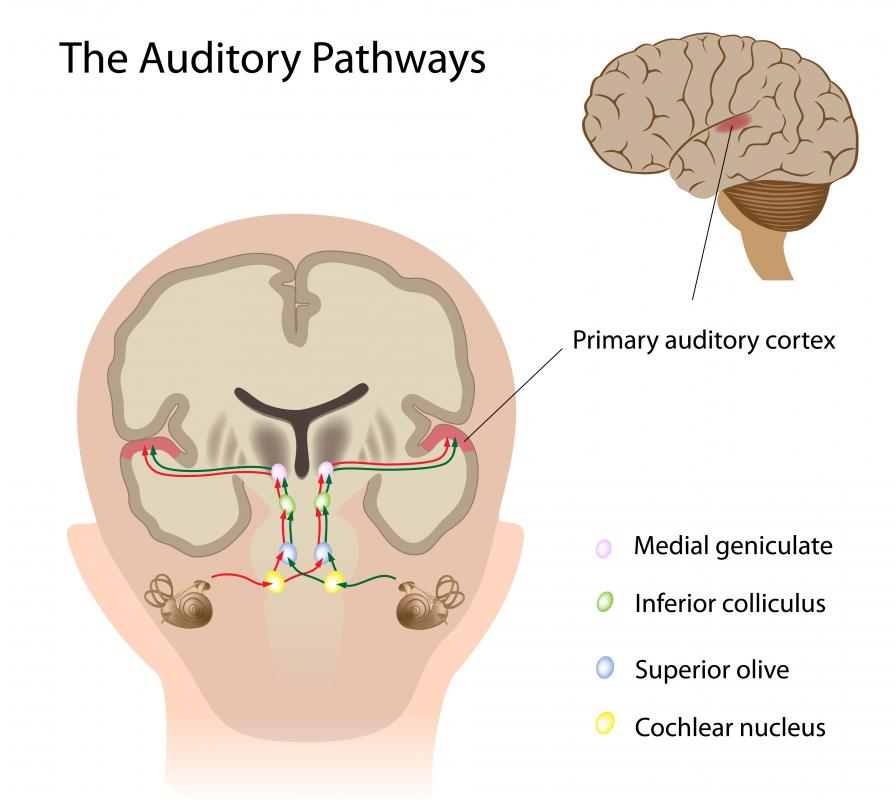At TheHealthBoard, we're committed to delivering accurate, trustworthy information. Our expert-authored content is rigorously fact-checked and sourced from credible authorities. Discover how we uphold the highest standards in providing you with reliable knowledge.
What is Auditory Perception?
Auditory perception is the ability to perceive and understand sounds, usually with specific organs, such as a human's ears. Sound exists in the form of vibrations that travel through the air or through other substances. Ears detect such vibrations and convert them into nerve impulses, which are then sent to the brain where they can be interpreted. Deafness describes a condition in which individuals have no auditory perception; deaf individuals are not capable of perceiving or interpreting sounds. Different animals can perceive different sounds; dogs, for example, are capable of perceiving very high-pitched sounds that humans cannot perceive.
There are many factors that affect auditory perception beyond simply hearing sounds. The brain is largely responsible for many processes that can turn a mass of incoming noise into something useful and understandable. Auditory discrimination is the process by which one is able to note the differences between sounds; this is extremely important to language as spoken words are understood based on different sounds. Discrimination between foreground and background is also an important part of auditory discrimination. It is important to be able to focus on important noises and to ignore irrelevant and unimportant noises so that one is not overwhelmed by a vast amount of noise.

Auditory synthesis is another process very important to the comprehension of language. It describes the process by which the brain combines different sounds into understandable units, similar to the way letters are combined into words and words into sentences. Auditory sequencing is a process closely related to both memory and auditory perception. It describes the ability to understand and remember the order in which certain sounds happened.

Individuals who have hearing problems may simply have difficulty hearing quiet sounds or extreme pitches. They may also, however, have problems with the above processes that are essential to making sense of sounds. Problems with auditory perception can exist from birth, or they can be caused by injuries to the brain or ears. They are generally easy to detect; one with hearing problems either cannot hear well or cannot make sense of the sounds that he hears.

Some children suffer from a loss of auditory perception from birth. There are many ways to detect hearing problems in children. Often, they do not understand or respond to auditory signals or commands. They ask for directions to be repeated, often several times. In many cases, they watch what others are doing before taking any action of their own.
AS FEATURED ON:
AS FEATURED ON:















Discussion Comments
Be careful not to confuse auditory reception with auditory perception. Reception being the ability to hear (receive sounds). Perception being the way the brain to makes sense of what is being heard
The inability to discriminate between foreground sounds and sound or noise in the background is a very trying situation especially for a child. As a teacher, I have known a number of children with this auditory problem. They are not able to concentrate on what someone is saying to them. They become distracted, edgy,and frustrated with all the noise in the background swimming in their heads.
Ideally, they learn best in a small group environment that is fairly quiet with a minimum of background noise.
When children are preschoolers, I feel that they need to learn the skill of phoneme awareness. First they learn that sentences are made up of words. Being able to hear when one word begins and ends is a start. Next, is understanding that words are made up of syllables and being able to discriminate syllables. Lastly, they learn to hear the separate sounds that make up a syllable.
There are many exercises and games to teach children these auditory skills. This is the best way to prepare them to learn phonics and then reading in kindergarten.
@miriam98 - I think that while teachers weigh their options for approaches to language instruction, it would be best to give each child an auditory perception test to find out exactly where they’re at.
That way you can make an informed decision about how to educate them, without the static of politically charged debates about whether phonics or whole language is the best route.
You can buy such tests online. They have instruction manuals and auditory perception activities for the children. You’ll be able to quickly evaluate how well the children comprehend in a variety of contexts, and these kits also provide remedial material to help the child catch up in areas identified as weak.
@Mammmood - I’m not sure if what you’ve described is auditory perception or auditory synthesis-I think it’s the latter. But one other application of auditory synthesis is in the domain of language processing.
I have some experience in the education profession, K-12 mainly, and I can tell you that one subject which triggers heated debate is phonics. Some educators will insist that phonics, which of course is very depending on phonemes and sounding out letters, is the only way to teach reading. I can attest that the bulk of peer reviewed literature backs them up on that.
However, other educators state that some children, particularly those with an auditory processing disorder, need to use whole language or a sight-read method.
The sparks fly in these debates, but in my opinion the connection between auditory synthesis and language processing is settled. Just try reading a book without “sounding it out.”
Reading about auditory perception, I can’t but help ask the old riddle: If a tree falls in the forest and no one is around to hear it, does it make any sound? I think the technical answer would be that it makes sound vibrations but there is no auditory processing to make sense of it.
In other words, it’s like the distinction between data and information: data are raw symbols in the form of letters and numbers, but information is the processing of that data into something meaningful, in a context.
Perhaps I’ve oversimplified the analogy; however, it’s amazing to think that the human ear has to filter through so many sounds-meaningless “chatter”-to discriminate those sounds that are worth listening to and provide meaning for us.
Post your comments